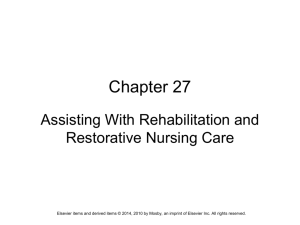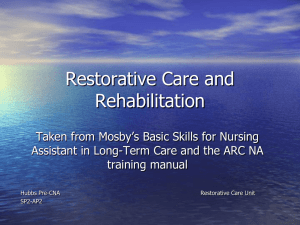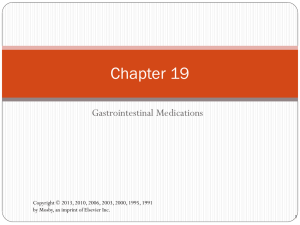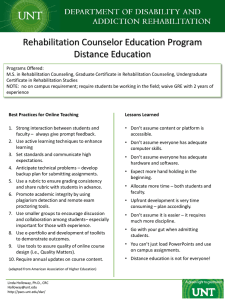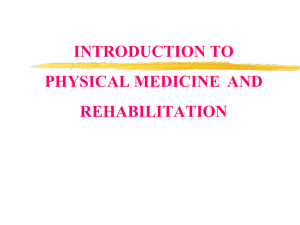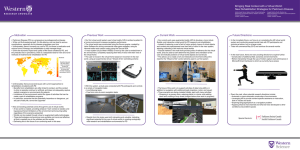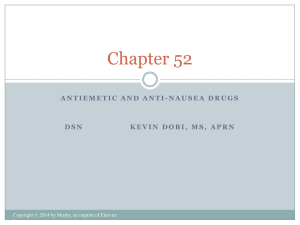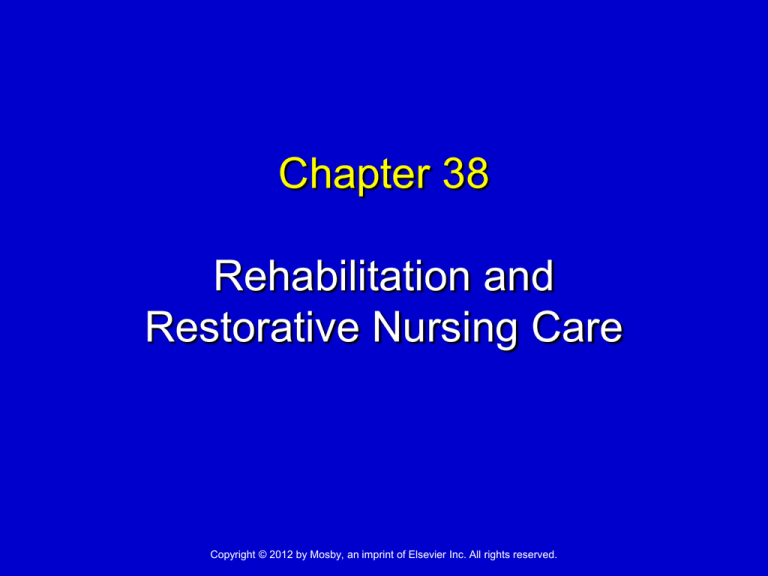
Chapter 38
Rehabilitation and
Restorative Nursing Care
Copyright © 2012 by Mosby, an imprint of Elsevier Inc. All rights reserved.
Disability
Body function can be affected by:
Disease, injury, and surgery
Birth injuries and birth defects
Often, more than one function is lost.
Losses are temporary or permanent.
The whole person is affected
Copyright © 2012 by Mosby, an imprint of Elsevier Inc. All rights reserved.
Slide 2
Disability (cont’d)
A disability is any lost, absent, or impaired
physical or mental function.
Causes are:
• Acute—short course; recovery is complete ie fracture
• Chronic—long course; problem is controlled–not curedwith treatment ie stroke, spinal cord injury
The person may depend totally or in part on
others for basic needs.
• The degree of disability affects how many functions are
lost and how much function is possible
Goals of health care are:
• Prevent and reduce the degree of disability.
• Help the person adjust.
Copyright © 2012 by Mosby, an imprint of Elsevier Inc. All rights reserved.
Slide 3
Rehabilitation
Rehabilitation is the process of restoring the
person to his or her highest possible level of
physical, psychological, social, and economic
function. OBRA required to provide!!!
The focus is on improving abilities and what the
patient can do.
• The goal may be to return to work.
• Another goal is self-care.
Improved function is sometimes not possible.
• Then the goal is to prevent further loss of function.
Some persons return home after rehabilitation.
• The process may continue in home or community
settings. Assessment is done by rehab team.
Copyright © 2012 by Mosby, an imprint of Elsevier Inc. All rights reserved.
Slide 4
Restorative Nursing
Restorative nursing care is care that helps
persons regain health, strength, and
independence.
Restorative nursing programs:
Help maintain the highest level of function
Prevent unnecessary decline in function
Involve measures that promote:
• Self-care
• Elimination
• Positioning
• Mobility
• Communication
• Cognitive function
Copyright © 2012 by Mosby, an imprint of Elsevier Inc. All rights reserved.
Slide 5
Restorative Nursing (cont’d)
A restorative aide is a nursing assistant with
special training in restorative nursing and
rehabilitation skills.
These aides assist the nursing and health teams
as needed.
Required training varies among states.
Copyright © 2012 by Mosby, an imprint of Elsevier Inc. All rights reserved.
Slide 6
Rehabilitation and
the Whole Person
A disability has physical, psychological, and
social effects.
The person needs to adjust physically,
psychologically, socially, and economically.
Abilities are stressed.
Complications are prevented.
Copyright © 2012 by Mosby, an imprint of Elsevier Inc. All rights reserved.
Slide 7
Rehabilitation and
the Whole Person (cont’d)
Physical aspects
Rehabilitation starts when the person first seeks
health care.
Complications are prevented.
• Bowel and bladder problems are prevented.
• Contractures and pressure ulcers are prevented.
Copyright © 2012 by Mosby, an imprint of Elsevier Inc. All rights reserved.
Slide 8
Rehabilitation and
the Whole Person (cont’d)
The following may be needed:
•
•
•
•
•
•
•
•
•
•
•
•
•
•
Good alignment, turning, and re-positioning
Range-of-motion exercises
Supportive devices
Good skin care
Bladder training
Bowel training
Assistance with activities of daily living (ADL)
Self-help devices (ie wrists disabilities)
Crutches or a walker, cane, or brace
Physical and occupational therapies
A prosthesis-artificial replacement for a missing part
Assistance with nutritional needs
Speech therapy and communication devices ie aphasia
Mechanical ventilation
Copyright © 2012 by Mosby, an imprint of Elsevier Inc. All rights reserved.
Slide 9
Rehabilitation and
the Whole Person (cont’d)
Psychological and social aspects
A disability can affect function and appearance.
•
Self-esteem and relationships may suffer.
The person may deny the disability.
The person may expect therapy to correct the problem.
Successful rehabilitation depends on the person’s attitude.
The focus is on abilities and strengths.
Psychological and social needs are part of the care plan.
Spiritual support helps some persons.
Economic aspects
The goal is for the person to become gainfully employed.
Copyright © 2012 by Mosby, an imprint of Elsevier Inc. All rights reserved.
Slide 10
The Rehabilitation Team
Rehabilitation is a team effort.
Families provide support and encouragement.
The person is the key team member.
The family, doctor, and nursing and health teams
help the person set goals and plan care.
The focus is on regaining function and
independence-allow time to complete tasks
Often, they help with home care.
Your job focuses on promoting the person’s
independence.
Preventing decline in function also is a goal.
Copyright © 2012 by Mosby, an imprint of Elsevier Inc. All rights reserved.
Slide 11
Rehabilitation Programs
and Services
Common rehabilitation programs include:
Cardiac rehabilitation
Brain injury rehabilitation
Spinal cord rehabilitation
Stroke rehabilitation
Respiratory rehabilitation
Musculo-skeletal rehabilitation
Rehabilitation for complex medical and surgical
conditions
Copyright © 2012 by Mosby, an imprint of Elsevier Inc. All rights reserved.
Slide 12
Rehabilitation Programs
and Services (cont’d)
The rehabilitation process may continue after
hospital discharge.
The person may transfer to a nursing center or to
a rehabilitation agency.
Home care agencies, some assisted living
residences, and some adult day-care centers
also provide rehabilitation services.
The patient may need both rehab and restorative
care
Copyright © 2012 by Mosby, an imprint of Elsevier Inc. All rights reserved.
Slide 13
Quality of Life
Successful rehabilitation and restorative care
improve quality of life.
The more the person can do alone, the better his
or her quality of life. To promote quality of life:
Protect the right to privacy.
Encourage personal choice.
Protect the right to be free from abuse and
mistreatment.
Learn to deal with your anger and frustration.
Encourage activities.
Provide a safe setting.
Show patience, understanding, and sensitivity.
Copyright © 2012 by Mosby, an imprint of Elsevier Inc. All rights reserved.
Slide 14
https://www.youtube.com/watch?feature=play
er_detailpage&v=DT7ZH69Oe3c
Copyright © 2012 by Mosby, an imprint of Elsevier Inc. All rights reserved.
Slide 15

